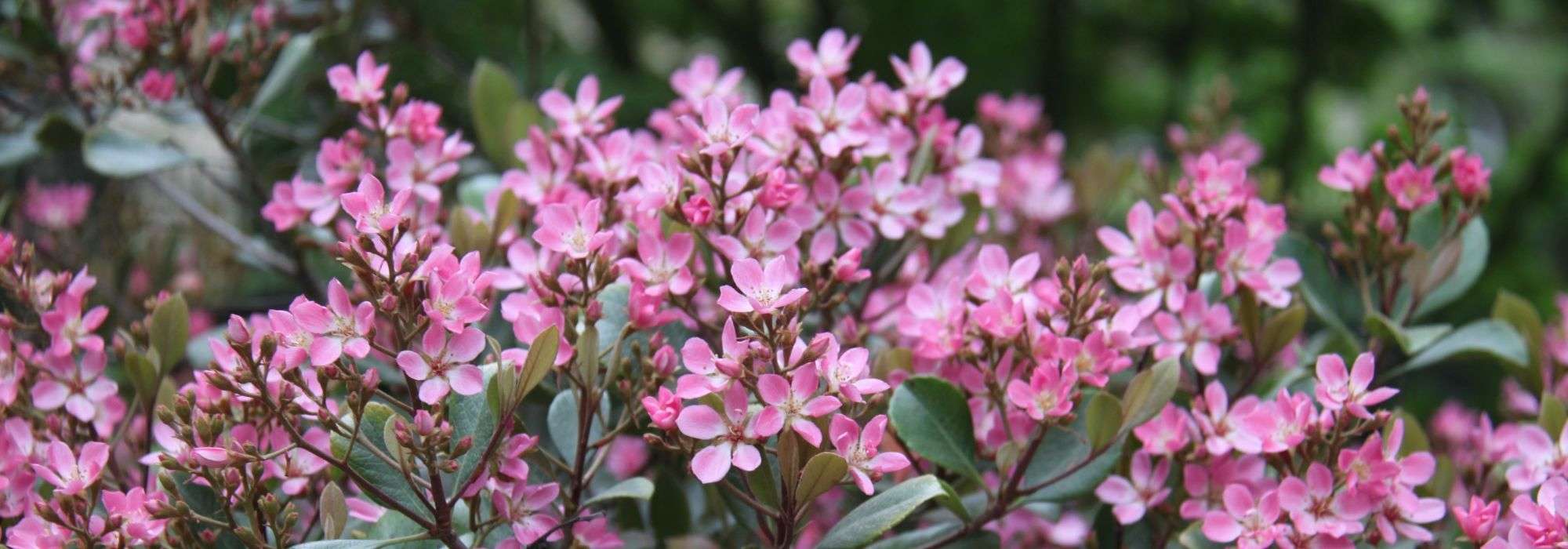
Rhaphiolepis: planting, pruning, care
Contents
Rhaphiolepis in a nutshell
- Rhaphiolepis is a bush for mild climates, with attractive foliage all year round, glossy green in summer, tinged with red at bud burst period and in autumn
- It has a neat, compact rounded habit and a long display of white or pink flowers that are pleasantly scented
- Hardy down to -10°C, it is best suited to dry or coastal gardens with relatively mild winters
- Its modest size suits small gardens and growing in containers
- It is also an excellent choice for an informal hedge or a shrub border
A word from our expert
Still far too little known, Rhaphiolepis is nonetheless a small bush with a nicely rounded habit that proves very floriferous from spring to late summer. It charms as much with its evergreen, glossy olive-green foliage that changes, giving this bush an attractive appearance year-round, as with its pleasantly scented flowering.
With a moderate size of between 1 and 2 m in height, and delicate flowers ranging from white in Rhaphiolepis ‘umbellata Ovata’ to pink in Rhaphiolepis ‘Springtime’, ‘Coates Crimson’ and ‘Pink Cloud’, it makes an original small bush perfect for confined spaces or to be grown in a pot. There is even a little-known dwarf form, Rhaphiolepis umbellata ‘Minor’, ideal for low hedges or border edges. Rhaphiolepis delacourii, meanwhile, is a widely cultivated hybrid resulting from cross-breeding between Rhaphiolepis indica and Rhaphiolepis umbellata, equally appealing and slightly less tender.
Hardy down to around -10°C, requiring little water, resistant to sea spray and drought as well as to pollution, Rhaphiolepis is valuable in dry gardens and seaside gardens sheltered from severe frosts.
Elsewhere, it can be grown without difficulty in a large pot placed on a terrace from May to October, allowing it to be sheltered from harsh winter frosts.
Grow this bush with lovely foliage and delicate flowering, perfect for borders, small flowering hedges, rockeries, or container cultivation in the coldest regions!
Description and botany
Botanical data
- Latin name Rhaphiolepis
- Family Rosaceae
- Common name Rhaphiolepis, Indian hawthorn
- Flowering April to July–August
- Height 1 to 2 m
- Exposure Sun, partial shade
- Soil type neutral, acid, dry
- Hardiness -8 to -10°C
Rhaphiolepis is an evergreen bush of family Rosaceae native to warm, rather dry lower-mountain regions of Asia (China, Japan and Korea). Of moderate hardiness but very tolerant of drought and sea spray, it prefers southern, Mediterranean or oceanic climates to montane or continental ones.
The genus includes fewer than ten species, among which Rhaphiolepis indica (syn. Crataegus indica) or Rhaphiolepis des Indes (sometimes called “Indian hawthorn”), little cultivated in our climates, and Rhaphiolepis umbellata (syn. japonica) or Japanese Rhaphiolepis. The Rhaphiolepis x delacourii or Rhaphiolepis de Delacour is a hardier hybrid resulting from cross-breeding between these two species.
Rhaphiolepis displays a bushy, spreading habit, naturally rounded with a neat outline. Almost as tall as wide, it slowly forms a small, very ramified bush of 1 to 2 m, nearly as wide.
Young reddish-brown shoots bear particularly decorative evergreen foliage offering changing hues through the seasons as the olive green of mature leaves blends with the purplish green of young shoots. Leaves are alternate, narrow, leathery, entire, elliptical or spatulate, with almost smooth margins finely dentate in their upper part and ending in a point. They measure 5 to 10 cm in length. They emerge bronze-green and covered with white pubescence at bud burst period, then take on a glossy olive green above and a bluish colour beneath in summer, before revealing beautiful red tones at first frosts.
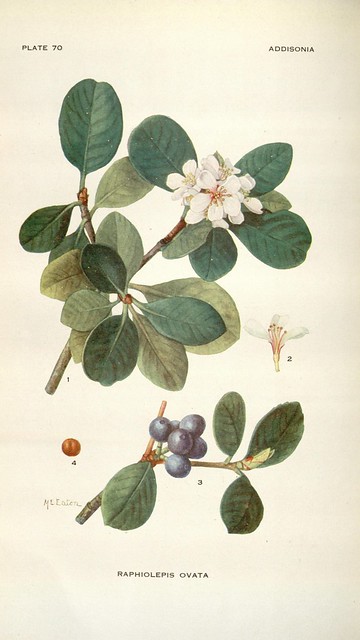
Raphiolepis ovata – botanical illustration
Spring or summer flowering occurs from March–April through to August, depending on climate. But it is at the heart of spring that flowering is most generous. The glossy foliage then becomes covered with a profusion of small star-shaped flowers gathered in light panicles at the tips of purplish young shoots.
Each cluster bears around ten small five-petalled flowers as in all plants of family Rosaceae, pearly, oval, 1 to 3 cm wide. They are accompanied by pointed bracts, which gave the bush its name, meaning “needle”. These flowers, from pale pink, powder-pink to bright carmine pink depending on variety, recall simplicity of apple blossoms. Each is delicately set within a pretty green calyx tinged with red and reveals at its heart a tuft of white or purple stamens that enhance its brilliance.
These delicate, very melliferous corollas exhale a fresh scent that attracts pollinating insects.
Once faded, flowers give way to small pruinose berries pear-shaped, red then blue-black at ripeness, which remain on the bush for a long time.
Although hardy to -10/-12°C, Rhaphiolepis prefers mild winters and is ideally grown in Mediterranean or south-Atlantic climates. In colder regions, it is preferable to grow it in pots and overwinter it sheltered from severe frosts.
This bush dislikes icy winds and severe cold but tolerates drought and sea spray in coastal gardens.
Plant in a sunny or semi-shaded position, sheltered from winds and cold drafts. Undemanding as to soil type, slightly acidophilous, it prefers light, well-drained soils, neutral to acidic. It dislikes heavy, waterlogged soils, especially in winter.
Versatile, Rhaphiolepis integrates perfectly into all gardens with mild winters and is ideal for small spaces. Its modest dimensions and elegant silhouette allow many uses: in borders, as a flowering hedge and even grown in a large pot in regions with mild winters.
Read also
10 perfect bushes for a seaside gardenMain species and varieties
All Rhaphiolepis umbellata, indica or delacourii are evergreen bushes that tolerate sea spray and adapt very well to container growing, and can be brought indoors for winter in the coldest regions, as their hardiness is around -10 to -12°C in sheltered situations. Here is our selection of bushes that will make an impact from the first years of cultivation.
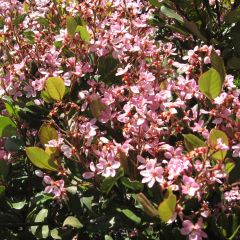
Rhaphiolepis indica Springtime
- Flowering time June to August
- Height at maturity 1,50 m
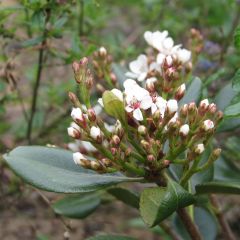
Rhaphiolepis umbellata f. ovata
- Flowering time June to August
- Height at maturity 1 m
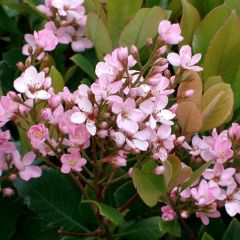
Rhaphiolepis delacourii Coates Crimson
- Flowering time May to August
- Height at maturity 1,10 m
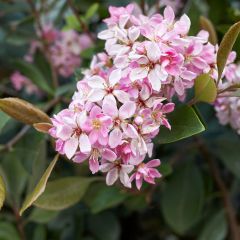
Rhaphiolepis indica Pink Cloud
- Flowering time June to August
- Height at maturity 1,10 m
Discover other Rhaphiolepis
View all →Available in 1 sizes
Available in 1 sizes
Available in 2 sizes
Available in 1 sizes
Available in 1 sizes
Available in 1 sizes
Planting
Where to plant Rhaphiolepis?
With moderate frost tolerance, down to -10/-12°C, Rhaphiolepis is best planted in regions south of the Loire, in meridional, Mediterranean or oceanic climate where winters are relatively mild. Plant in a sheltered spot, protected from cold winter winds and draughts that damage its evergreen foliage and flowering, for example beside a south-facing wall. It will appreciate a well-sheltered position if you wish to try growing it in an area with harsh winters, although in cold regions we recommend planting in pots and moving them to shelter during severe frosts.
Rhaphiolepis proves resistant to sea spray and to pollution, making it a good bush for seaside and urban gardens. This bush is also a boon for dry gardens.
It prefers full sun to flower well but will tolerate partial shade, particularly in warm climates.
As for soil, it shows a marked sensitivity to lime and will grow easily in neutral to slightly acidic, light soils rich in well-rotted compost and, above all, well drained: once well rooted, it will even tolerate occasionally dry soil in summer. It truly only fears heavy, waterlogged soils in winter.
Wider than tall, of moderate size, Rhaphiolepis can be used in a small flowering hedge, as an edge to a perennial bed or with other bushes, in a large rockery, or in a pot on a sheltered terrace or balcony to fully enjoy its fragrance.
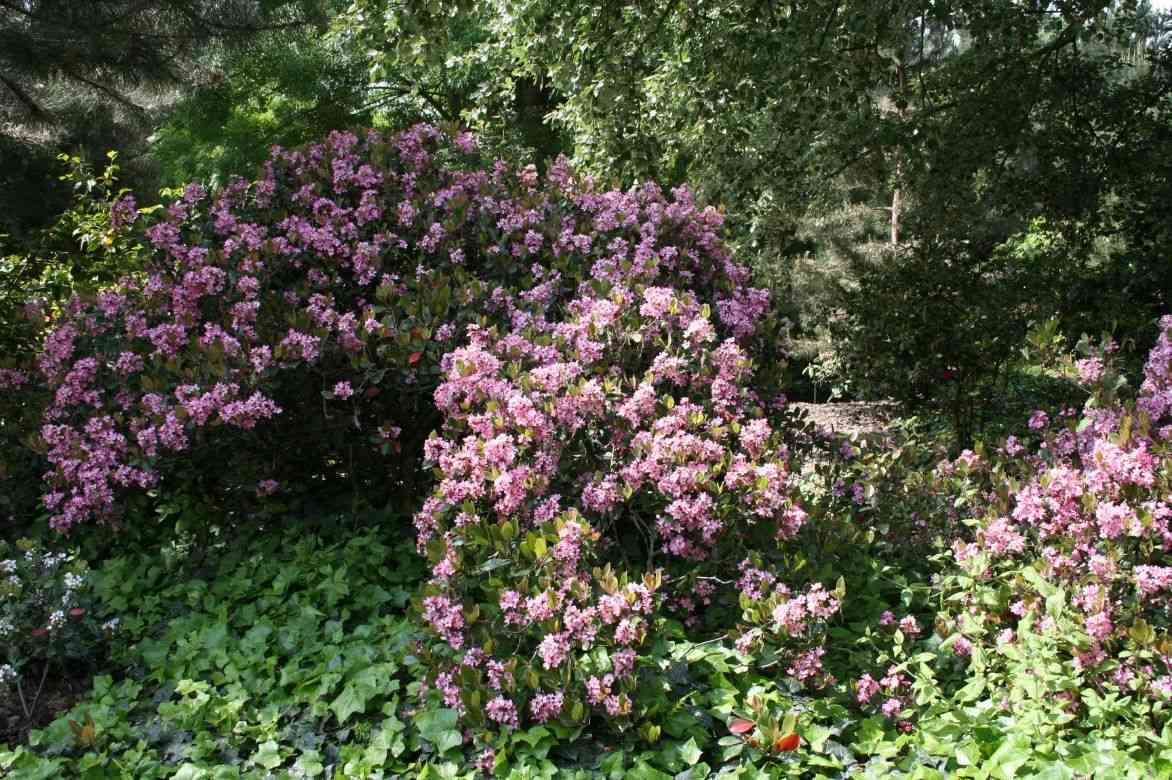
When to plant Rhaphiolepis?
Planting Rhaphiolepis is best done in spring, from March to June, or in autumn in mild climates.
How to plant Rhaphiolepis?
Depending on use, space plants 80 cm to 1 m apart.
In open ground
Rhaphiolepis dislikes soils that are too heavy and poorly drained. Improve drainage if necessary by adding coarse sand, gravel and some well-rotted compost. If soil is too calcareous, be sure to add heather soil and compost.
- Soak rootball for 15 minutes in water
- Dig a hole 3 to 4 times wider than the bucket
- Spread gravel to help drainage
- Make a small mound at bottom of hole to support roots
- Place bush at centre of planting hole, collar level with soil
- Backfill, taking care not to break rootball
- Firm down with foot
- Water copiously after planting
- Mulch around base
Find even more tips for successful planting in our video.
In a pot
Container culture is easy as the bush remains fairly modest in growth and is simple to contain.
- Lay a layer of drainage clay balls at bottom of a container at least 45 cm in diameter
- Plant in a mix of heather soil and potting compost
- Mulch to keep roots cool
- In cold regions, move pots to shelter from severe frosts
Read also
10 bushes to grow in acidic soilMaintenance, pruning and care
During the first two years, monitor water needs of your Rhaphiolepis to encourage establishment. Once established, this will no longer be necessary, it is a bush that tolerates drought well.
In a pot, water once a week and reduce waterings in winter. In mild areas, in winter shelter pots from rain and frost. In colder regions, in October move them to a frost-free conservatory or an unheated greenhouse and put them back out in May. Top-dress each spring and repot every 3 years.
It is advisable to mulch the base generously before summer to keep roots cool and, in winter, to protect the stump from frost. A winter fleece can help protect above-ground parts from severe cold and dry, icy winds.
Given its slow, modest growth habit, pruning is not essential. Just after flowering, carry out a light pruning to remove faded flowers and, if necessary, thin, dead or damaged shoots.
Potential pests and diseases
This bush is not very susceptible if growing conditions are respected.
In poorly drained soil, in an overly rainy climate or if moisture stagnates at the roots, Rhaphiolepis will mainly suffer from fungal diseases, notably Entomosporium maculatum. Entomosporiosis causes round reddish-brown spots to appear on leaves, which eventually turn yellow and fall. Remove affected leaves and twigs and collect fallen dead leaves from the ground. As a preventative in spring, as soon as new shoots appear, spray Bordeaux mixture and regularly spray nettle manure.
If soil contains excess lime, this bush may develop a chlorosis: leaves discolour and turn yellow. Water only with rainwater and try to improve the soil by adding heather soil, forking it in around the base.
Propagation: propagation by cuttings, layering
The simplest and quickest method to multiply Rhaphiolepis is propagation by cuttings. It is also possible to layer the bush in autumn. You can also try sowing in late winter under a cold frame or in an unheated greenhouse, as fresh seeds germinate very quickly in about ten days.
Propagate Rhaphiolepis by cuttings
In July–August, when shoots begin to harden into wood, take semi-ripe cuttings.
- After flowering, take cuttings about 6 to 10 cm long
- Remove all leaves from the lower part
- Cut just below a leaf node and strip bark for a few centimetres
- Insert cuttings into a mix of turf and river sand, spacing them 5 cm apart
- Keep moist
- Keep covered in a mini greenhouse until autumn
- Then keep rooted cuttings protected from frost during winter
- Plant out in soil or pot up in spring
By layering
- In October, bend a low branch down towards soil
- Remove leaves touching soil and nick bark slightly
- Dig a hole 10 cm deep and add a few handfuls of moist compost
- Bury the exposed branch so it can root
- Stake the aerial part and cover with compost
- Water generously
- The following spring, separate the layer from the mother plant if it has enough roots: cut the stem where it enters the soil
- Replant in chosen spot in garden
Associate
Water‑thrifty, Rhaphiolepis is a very interesting bush for a dry garden with no irrigation. It brings colour and density to borders and rockeries and can be used equally well as an informal flowering hedge, as a specimen or even in a pot. With its glossy evergreen foliage, it makes a handsome decorative subject all year round.
It suits perfectly in a scree garden, on a large bank planted with Mediterranean bushes or sun‑loving perennials such as Cistus, Abutilon, Callistemons, woody thymes, artemisias, Ballota, Phlomis, Teucrium.
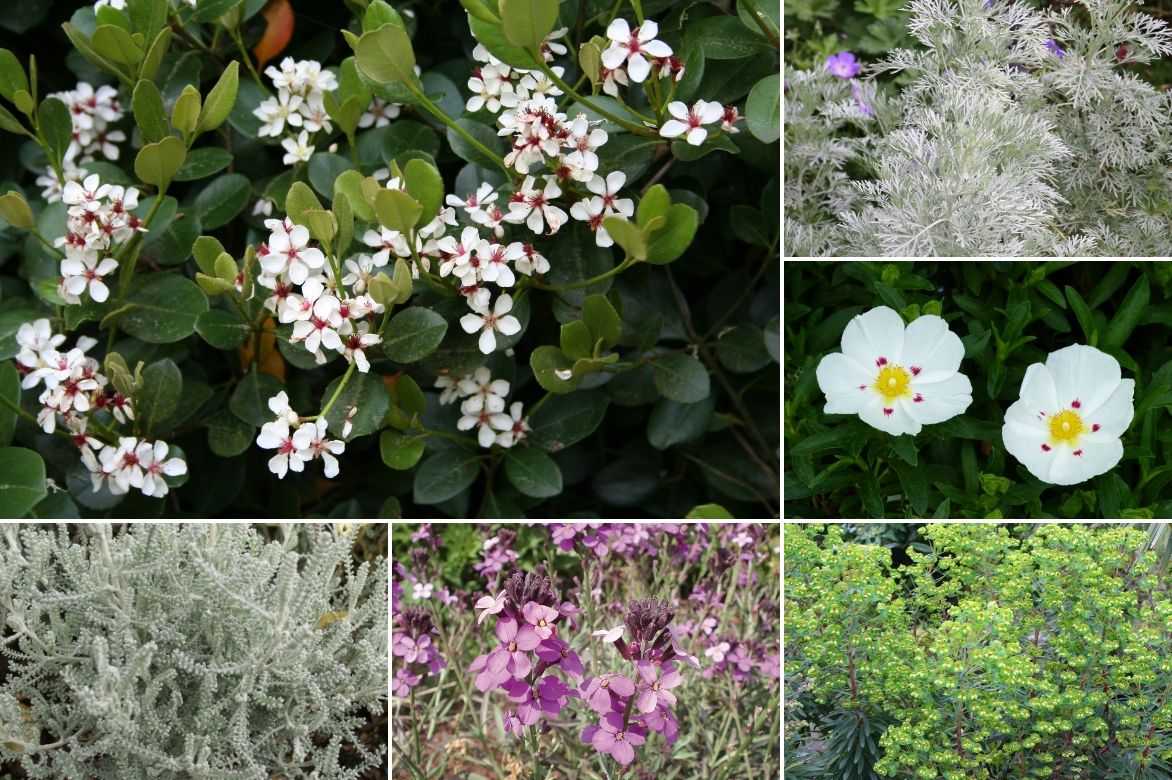
An idea for a sunny combination, in very free‑draining soil: Raphiolepis ovata, Artemisia arborescens ‘Powis Castle’, Cistus x loretii, Euphorbia martinii, Erysinum Bowl’s Mauve and Santolina chamaecyparis
In a large bed, it can be paired with bushes that flower in summer or spring such as California lilacs, Kolkwitzia amabilis, Leptospermum, Melaleuca and buddleias for attractive, low‑maintenance flowering displays.
Its tolerance to sea spray makes it ideal for seaside planting as an evergreen hedge with Olearia and Escallonia.
In an evergreen, flowering hedge, it will accompany Abelias, Pieris, Japanese azaleas, Cotoneasters, Japanese Euonymus and Hebes or shrubby veronicas.
It will be companion to other acidophilous bushes such as Kalmias, Deutzias, Azaleas, Hydrangeas, Rhododendrons or Camellias that will complement its flowering.
Its pink flowers and reddish shoots pair well with red‑flowering plants such as Achillea, Coreopsis, shrubby sages, Penstemon and the purple foliage of some Heuchera or shrubs like Cotinus or Acer.
Useful resources
- Discover our range of Rhaphiolepis as well as our selection of bushes to accompany it in a seaside garden!
- Best tips to choose and grow your bushes are on our blog!
- Subscribe!
- Contents
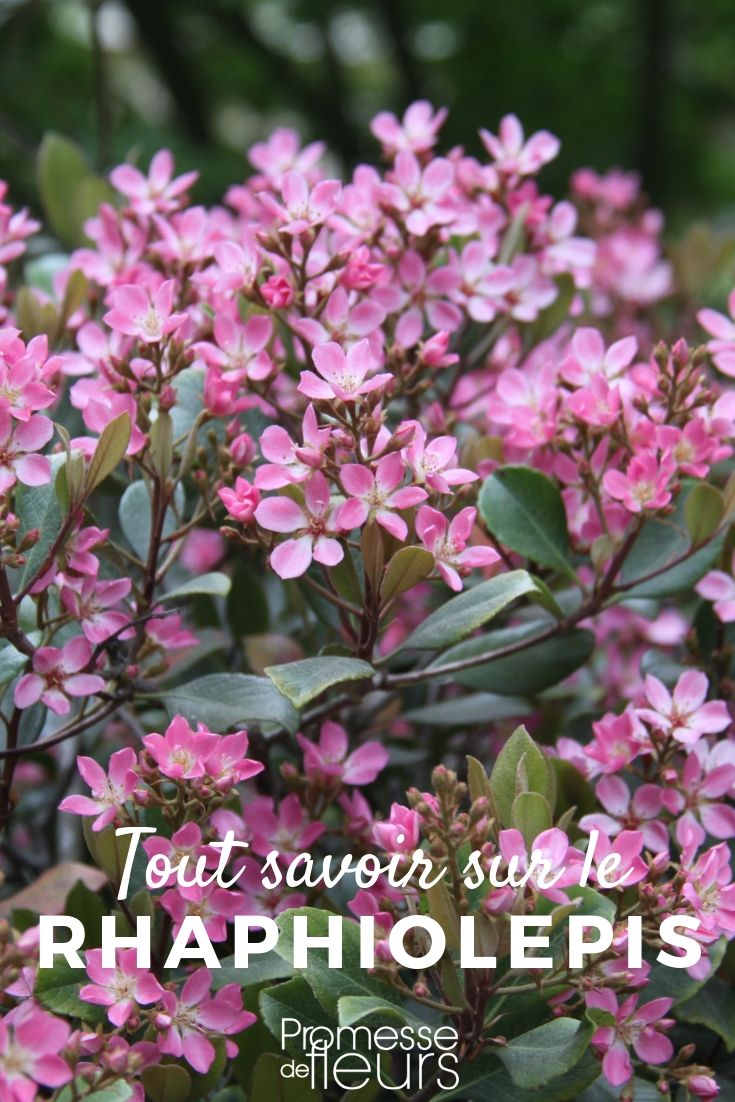































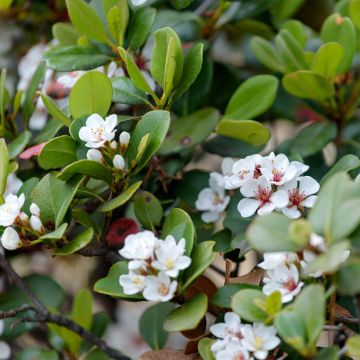


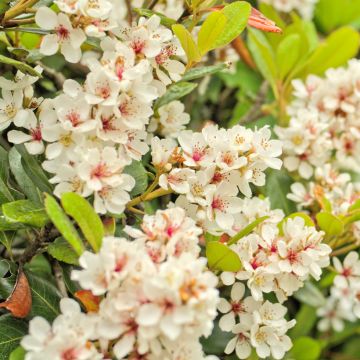



Comments